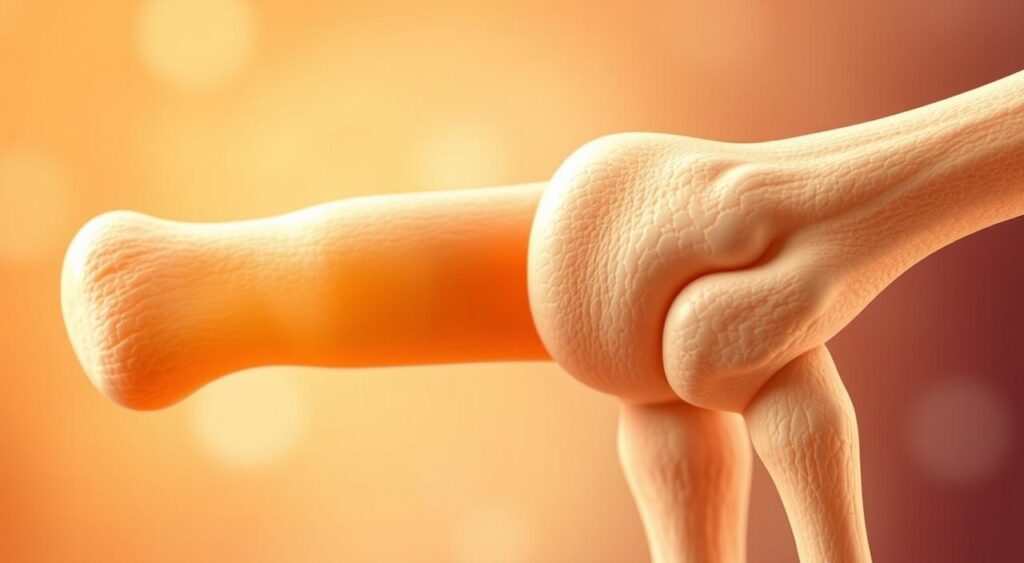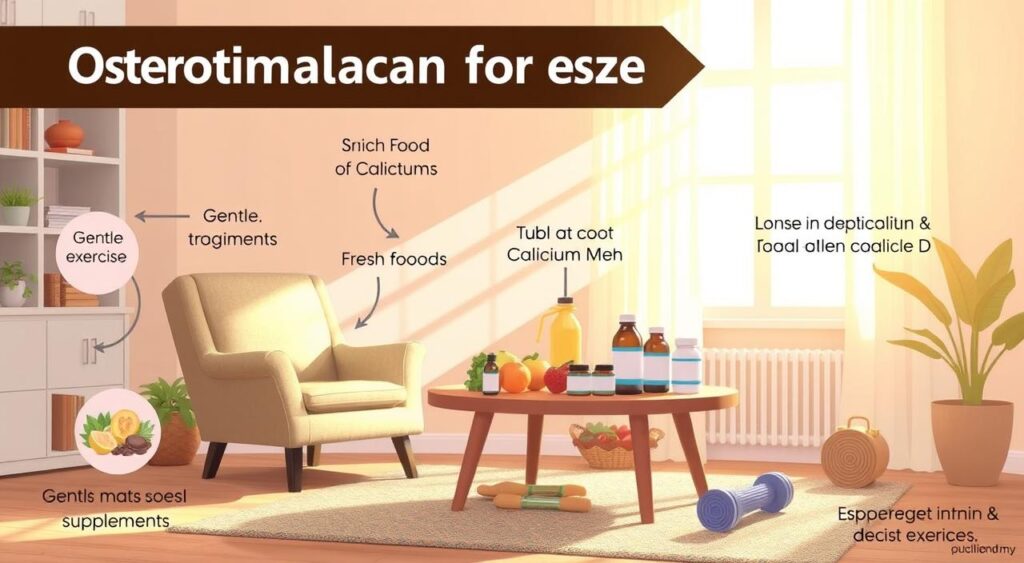Discover the causes, symptoms, and treatments for osteomalacia, a condition that softens the bones.
Osteomalacia : This condition makes bones soft. It’s a big health problem that affects millions globally, causing pain, discomfort, and trouble moving.

Osteomalacia weakens bones, making them break easily. It’s important to know what causes it, its symptoms, and how to treat it. By learning about osteomalacia, you can help keep your bones strong.
Key Takeaways
- Osteomalacia affects millions of people worldwide, causing bone softening and related health issues.
- The condition is often misunderstood, and its impact on bone health is substantial.
- Understanding the causes, symptoms, and treatment options is crucial for managing osteomalacia.
- Osteomalacia can be prevented and managed with lifestyle changes and medical interventions.
- Early diagnosis and treatment are essential for preventing long-term damage and complications.
- Individuals can take proactive steps to promote bone health and reduce the risk of osteomalacia.
Understanding Osteomalacia and Its Impact on Bone Health
Osteomalacia is a condition where bones become soft, often due to a vitamin D deficiency. This can weaken bone health and raise the risk of fractures. It’s key to know what osteomalacia is, how it affects the body, and who’s most at risk.
Vitamin D is vital for strong bone health. It helps the body absorb calcium, essential for strong bones. A lack of vitamin D can cause osteomalacia. Factors like age and less sun exposure can raise the risk of this deficiency.
What Is Osteomalacia?
Osteomalacia makes bones soft and weak. This can cause pain and increase the chance of fractures.
How Does It Affect the Body?
Osteomalacia impacts the body in several ways, including:
- Weakened bone health
- Increased risk of fractures
- Pain and discomfort
Who Is Most at Risk?
Some groups are more likely to get osteomalacia, including:
- Age
- Limited sun exposure
- Vitamin D deficiency
The Role of Vitamin D in Bone Health
Vitamin D is key for strong bones. A vitamin d deficiency can cause osteomalacia. This makes bones soft, leading to fractures and deformities.
Vitamin D helps bones by regulating calcium and supporting growth. It’s vital for bone health.
A vitamin d deficiency can happen for many reasons. These include not getting enough sun, eating poorly, and some health issues. It’s important to keep vitamin D levels up for good bone health.
This can be done by getting enough sun, taking supplements, and eating foods rich in vitamin D.
Strong bones are essential for health. Vitamin d deficiency can harm bone health a lot. Knowing how vitamin D helps bones can help prevent vitamin d deficiency and keep bones strong.
Common Causes of Osteomalacia
Osteomalacia makes bones soft, causing bone pain and muscle weakness. It can be caused by not getting enough nutrients, certain health issues, and some medicines.
Not eating enough vitamin D and calcium can lead to osteomalacia. Also, diseases like celiac and kidney problems can make it hard for the body to use these nutrients.
Nutritional Deficiencies
- Vitamin D deficiency: crucial for calcium absorption and bone health
- Calcium deficiency: essential for building and maintaining strong bones
Medical Conditions
Some health issues, like kidney and celiac disease, raise the risk of osteomalacia. These problems make it hard for the body to absorb needed nutrients, causing bone pain.
Medications and Treatments
Some medicines, like anticonvulsants and steroids, can also cause osteomalacia. They can stop the body from absorbing nutrients, leading to muscle weakness.
| Cause | Description |
|---|---|
| Nutritional Deficiencies | Lack of essential nutrients, such as vitamin D and calcium |
| Medical Conditions | Certain conditions, such as kidney disease and celiac disease, that impair nutrient absorption |
| Medications and Treatments | Certain medications, such as anticonvulsants and steroids, that interfere with nutrient absorption |
Recognizing the Signs and Symptoms
Osteomalacia can be hard to spot because its signs are often mild and can look like other health issues. Inadequate mineralization of bones is a main reason for osteomalacia, causing various symptoms. Bone pain is a common sign, which can affect many areas like the hips, legs, or ribs.
Muscle weakness is another symptom, making simple tasks hard. Low calcium levels can also cause muscle cramps, spasms, and tetany. Sometimes, osteomalacia can lead to deformities, like bowed legs or an abnormal spine curve.
Knowing these symptoms is key because early treatment can stop serious damage. Common signs of osteomalacia include:
- Bone pain or tenderness
- Muscle weakness or cramps
- Deformities, such as bowed legs or spinal curvature
- Difficulty walking or moving
- Increased risk of fractures
By spotting these signs, people can get medical help and start treatment. This can help manage their condition and avoid more problems.
Diagnosis Methods for Osteomalacia
To find out if someone has osteomalacia, doctors use physical checks, blood tests, and imaging studies. These steps help spot fragile bones and check bone health. Catching it early is key to stop bones from getting worse and to keep them healthy.
A physical check can show signs like bowed legs or a funny walk. Blood tests are also key, as they check vitamin D and calcium levels. Low levels of these can mean osteomalacia.
Diagnostic Tests
- Physical examination to assess bone deformities and muscle weakness
- Blood tests to measure vitamin D and calcium levels
- Imaging studies, such as X-rays or bone density scans, to evaluate bone density and health
Imaging studies like X-rays or bone density scans give important info on bone health. They help spot fragile bones and any shape changes. By mixing these tests, doctors can accurately find osteomalacia and create a good treatment plan to help bones stay strong.
Treatment Options and Management Strategies
Managing osteomalacia needs a full plan. This includes vitamin D supplements, changing your diet, and making lifestyle changes. Vitamin D is key because it helps bones stay strong. Taking vitamin D supplements can help fix this problem.
Eating right is also important. A diet full of calcium and vitamin D can help. Foods like fortified dairy and cereals are great sources of vitamin D. Also, eating foods high in calcium, like leafy greens and nuts, is good for your bones.
Vitamin D Supplementation
Vitamin D supplements are often given to those with osteomalacia. It’s important to take the right amount. Always talk to a doctor about how much to take.
Dietary Changes
Eating foods rich in calcium and vitamin D helps manage osteomalacia. Some good foods include:
- Leafy greens like broccoli and kale
- Nuts and seeds, such as almonds and sesame seeds
- Fortified dairy products, like milk and yogurt
Lifestyle Modifications
Changing your lifestyle can also help. Regular exercise and some sun exposure are good for bones. Exercise makes bones stronger, and sun helps make vitamin D in your skin.

By using these treatments, people with osteomalacia can manage their condition. It’s important to work with a doctor to find the right plan. This plan should fix vitamin D levels and help bones stay healthy.
Prevention Strategies and Risk Reduction
To lower the chance of getting osteomalacia, it’s key to focus on prevention. Keeping vitamin D levels up is crucial for bone health. Also, getting enough calcium is vital to keep bones strong and prevent softening.
Regular exercise is another important step in preventing osteomalacia. It helps lessen the risk of bone pain and other symptoms. Some prevention strategies include:
- Maintaining a balanced diet rich in vitamin D and calcium
- Engaging in regular physical activity, such as walking or weight-bearing exercises
- Avoiding medications that can interfere with vitamin D and calcium levels
By using these prevention strategies, people can lower their risk of osteomalacia and bone pain. It’s important to talk to a healthcare professional to find the best plan for you.
Stopping bone softening is key to keeping bones healthy and reducing pain. By focusing on prevention and taking action, people can protect their bones and lower the risk of osteomalacia.
| Prevention Strategy | Description |
|---|---|
| Maintain adequate vitamin D levels | Essential for bone health and preventing bone softening |
| Ensure sufficient calcium intake | Helps maintain strong bones and prevents bone softening |
| Engage in regular physical activity | Helps reduce the risk of bone pain and other symptoms associated with osteomalacia |
Living with Osteomalacia: Daily Management Tips
Managing osteomalacia means making lifestyle changes, eating right, and keeping an eye on your health. People with osteomalacia often feel muscle weakness. This can make everyday tasks harder and affect their happiness. Gentle exercises can help strengthen bones and muscles without making things worse.
Eating well is key to managing osteomalacia. It helps prevent inadequate mineralization of bones. Foods high in calcium and vitamin D, like dairy, leafy greens, and fortified cereals, are good choices. Also, talking to a dietitian can help create a meal plan that fits your needs.
Exercise Recommendations
- Low-impact aerobics, such as swimming or cycling, to improve cardiovascular health without putting excessive strain on joints
- Resistance training to build muscle mass and strengthen bones
- Flexibility exercises, such as yoga or Pilates, to improve range of motion and reduce stiffness

Diet Planning
Eating a balanced diet with whole foods can help with osteomalacia symptoms. Focus on foods like fruits, vegetables, whole grains, and lean proteins. This ensures you get all the vitamins and minerals you need.
Monitoring Progress
Keeping track of your health is important. It helps see if your management plan is working. You can track what you eat, your exercise, and your overall health. This helps find areas to improve and make your treatment better.
Conclusion: Taking Control of Your Bone Health
Osteomalacia is a condition that needs your active care. With the right knowledge and steps, you can manage your bone health. Knowing the risks of low calcium and fragile bones helps you spot osteomalacia early. This way, you can get medical help quickly.
Prevention is crucial. Make sure you have enough vitamin D, exercise regularly, and eat a diet full of calcium. If you think you’re at risk or have symptoms, talk to your doctor right away.
This guide has given you the tools to protect your bones and avoid osteomalacia. Take charge of your bone health. Make smart choices to keep your bones strong and healthy for many years.
FAQ
Q: What is osteomalacia?
A: Osteomalacia is a condition where the bones become soft. This happens when bones don’t get enough minerals. It can cause pain, weakness, and a higher chance of breaking bones.
Q: What causes osteomalacia?
A: The main reason for osteomalacia is a lack of vitamin D. Vitamin D helps the body use calcium, which is vital for strong bones. Other reasons include some diseases and certain medicines.
Q: Who is most at risk of developing osteomalacia?
A: Older people, those who don’t get enough sunlight, and those with certain health issues are at higher risk. This includes people with kidney or liver problems and those with malabsorption disorders.
Q: What are the symptoms of osteomalacia?
A: Symptoms include bone pain, muscle weakness, and a higher risk of fractures. People may also feel tired, have trouble walking, and find it hard to do physical activities.
Q: How is osteomalacia diagnosed?
A: Doctors use a physical exam, blood tests, and imaging like bone scans or X-rays. These help find the bone mineral levels and any bone changes.
Q: How is osteomalacia treated?
A: Treatment focuses on fixing the cause, often by taking vitamin D supplements. Eating foods high in calcium and vitamin D is also advised. Lifestyle changes, like more sun or exercise, help too.
Q: Can osteomalacia be prevented?
A: Yes, preventing osteomalacia is possible. Keep vitamin D levels up with sunlight or supplements. Eat foods rich in calcium and bone-supporting nutrients. Regular exercise also helps.
